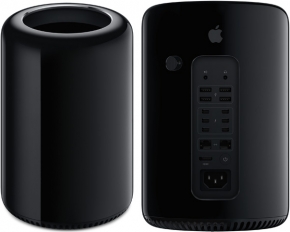
- #APPLE MAC PRO DESKTOP 2013 HOW TO#
- #APPLE MAC PRO DESKTOP 2013 FULL#
- #APPLE MAC PRO DESKTOP 2013 SOFTWARE#
- #APPLE MAC PRO DESKTOP 2013 MAC#
2880 x 1800), but renders things like text, menus and UI elements at 4x their normal resolution (2x in each dimension).
#APPLE MAC PRO DESKTOP 2013 FULL#
On a 13 or 15-inch MacBook Pro with Retina Display Apple renders the screen at full panel resolution (e.g. For editing photos and videos it’s great, but for everything else the ~30% increase in pixel density was just too much.Īpple actually created a solution to this problem with the MacBook Pro’s Retina Display. My eyesight isn’t what it used to be and 3840 x 2160 on a 32” panel is just past the borderline of comfortable for me. OS X (and Windows 8.1) running at 3840 x 2160 is incredible, but I find that text, menus and UI elements can be too small. Moving to Sharp’s 32” 4K PN-K321 brought back memories of my 30” days.
#APPLE MAC PRO DESKTOP 2013 MAC#
I’m a big fan of Apple’s 27” Cinema, Thunderbolt and iMac Displays as they integrate nicely with the Mac (hooray for brightness controls on the keyboard), and I’ve grown to be ok (and maybe even prefer?) the look of the glossy cover glass. I appreciated the reduction in desktop footprint and didn’t mind horribly the reduction in vertical resolution. Update: Apple addressed many of my 4K issues with OS X 10.9.3.įor years I used a 30” 2560 x 1600 panel, but when the first wave of 27” 2560 x 1440 displays hit I was instantly hooked. You can get it working in SST mode at 3840 x 2160 30Hz, but forcing MST results in a 1920 x 2160 display spread across both tiles with a mess of garbled colors. Dell sent along its UltraSharp 24 Ultra HD display (UP2414Q) for this review, and unfortunately that appears to be a display that’s not supported by the Mac Pro/OS X at this point. The same isn’t true, unfortunately, for other 4K displays on the market.

OS X will automatically recognize the display, configure it for 3840 x 2160 at 60Hz and you’re good to go. All you need to do is ensure that DisplayPort 1.2 MST is enabled on the display itself (something that appears off by default) and plug it into the Mac Pro. The Sharp PN-K321 that Apple sells alongside the Mac Pro (as well as the ASUS clone of it) ships with 4K60 support configured out of the box. Apple handles this by maintaining some sort of a whitelist for various displays they’ve tested. MST topologies for single-display/4K60 support aren’t standardized unfortunately.
#APPLE MAC PRO DESKTOP 2013 HOW TO#
The GPU driver needs to know how to divide its frame buffer for output to the individual tiles, which can vary between monitors.
#APPLE MAC PRO DESKTOP 2013 SOFTWARE#
The 4K/MST support requires a software component as well. I’m not sure if the Mac Pro’s GPU hardware can drive upcoming 4K single stream panels or not as AMD specifically lists that as a feature of the new Radeon R9 series. The first generation of 4K displays appear to be a bit of a hack. Note that it is possible to drive a 4K display at 60Hz using a single DisplayPort 1.2 stream, the limitation today appears to be entirely on the monitor side. By sending two tiles, each behaving like a 1920 x 2160 display (one half of 3840 x 2160), you can get around the bandwidth limitations of the current crop of display hardware. Originally conceived as a way of daisy chaining multiple displays together off of a single DP output, the current crop of 4K displays use MST to drive a single display. To support 4K at 60Hz, you need to properly enable support for DisplayPort 1.2’s Multi-Stream Transport (MST) feature. Contrary to what Apple’s own support documentation lists, these 4K resolutions at limited refresh rates are supported via both HDMI and Thunderbolt 2/DisplayPort 1.2 on the new rMBPs. That’s acceptable for use as a video preview display, but extremely frustrating for anything else (try watching a mouse cursor animate at 30Hz).

While the 2013 MacBook Pro with Retina Display can presently support outputting to either an 3840 x 2160 or 4096 x 2160 external panel, the maximum supported refresh rate is only 30Hz under OS X (and only 24Hz in the case of a 4096 x 2160 display). Alternatively you can connect up to six 2560 x 1440 displays using the Thunderbolt 2 ports at the back of the machine. You can connect two 4K displays via Thunderbolt 2/DisplayPort, and the third 4K display over HDMI. A huge part of the Mac Pro revolves around its support for 4K displays.


 0 kommentar(er)
0 kommentar(er)
